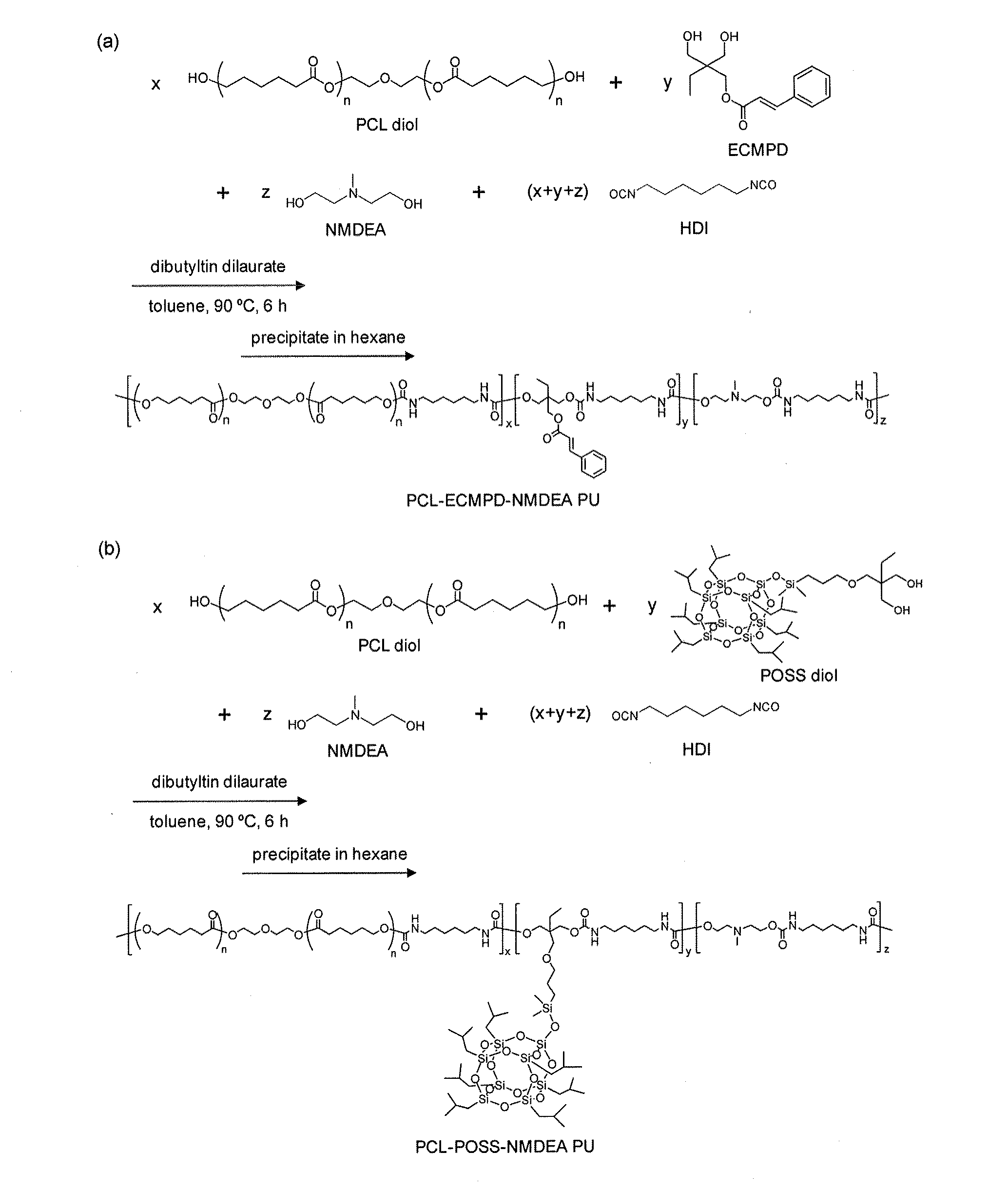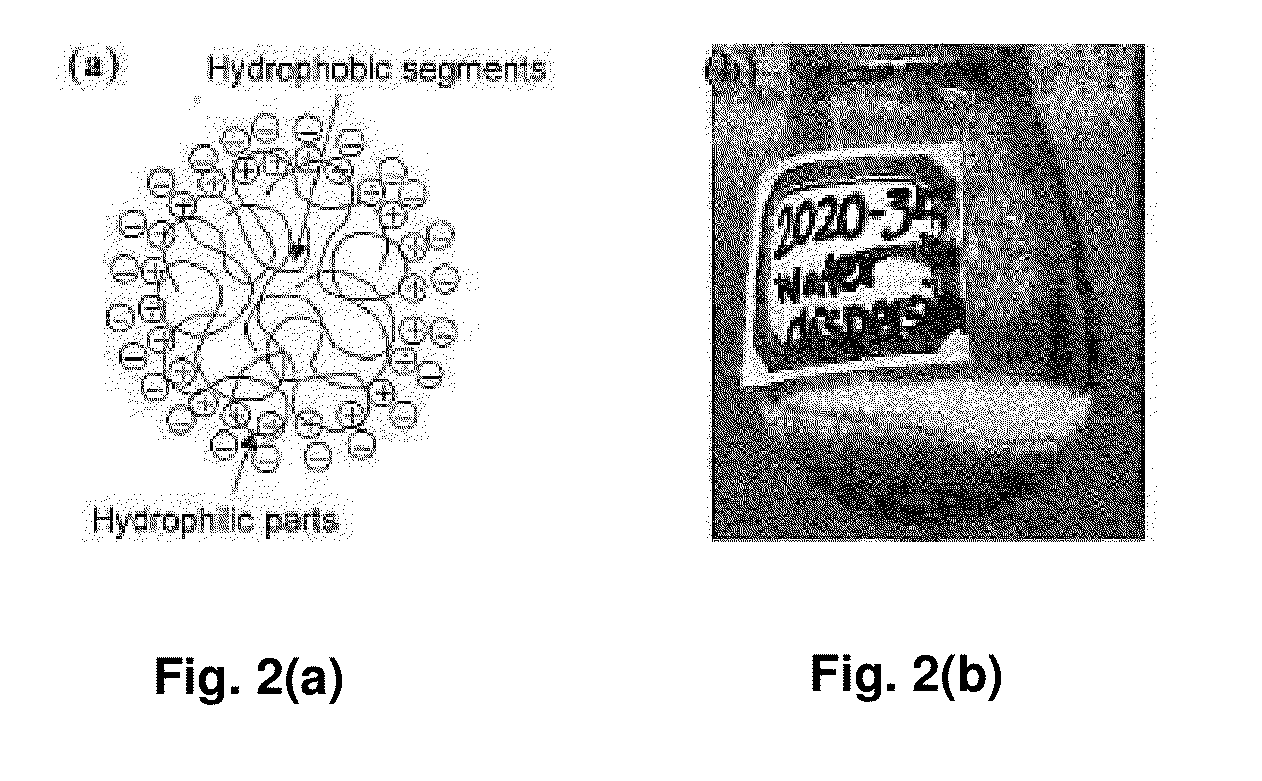Waterborne Shape Memory Polymer Coatings
a polymer coating and shape memory technology, applied in the field of shape memory polymer coatings, can solve the problems of difficult care for due to wrinkles, loss of desired effects under external influences, and inability to achieve organic solvent-bourne coatings that are not desirable for substrates, etc., and achieve enhanced performance characteristics and improved water absorption.
- Summary
- Abstract
- Description
- Claims
- Application Information
AI Technical Summary
Benefits of technology
Problems solved by technology
Method used
Image
Examples
example 1
[0084]This Example describes the aqueous dispersion of SMP, which can be prepared by means of a general method like the acetone process. In the acetone process, the uncharged SMP is reacted with a charging agent in the acetone solution (1-10 w / v %) with stirring at 25-50° C. for 1-10 hours, and preheated deionized water is added into the solution drop-wise with stifling at 45-60° C. Then acetone is evaporated at 65-75° C. with stifling or rotovapped at 25-60° C. The concentration of resulting aqueous dispersion can be reduced (for adjustment) by rotovapping. FIG. 2 (a) illustrates the anticipated structure of nano- or micro-particle of SMP dispersed in water. The hydrophobic segments are considered to be surrounded by the charged units so that the SMP can disperse in water, as shown in FIG. 2 (b).
[0085]The aqueous SMP dispersion can be used to coat the substrates according to the procedure shown in FIG. 3. After the coating of the substrate with the aqueous SMP dispersion, the coati...
example 2
Synthesis of 2-ethyl-2-cinnamoyloxymethyl-1,3-propanediol (ECMPD)
[0099]This Example describes the synthesis of 2-ethyl-2-cinnamoyloxymethyl-1,3-propanediol (ECMPD). TMP (50 g), acetone (300 mL), and p-TSA (50 mg) were introduced into a 500 mL round-bottom flask. The mixture was stirred for 2 days at room temperature. The solution was neutralized by adding 1.25 g of K2CO3, filtered, and evaporated with rotoevaporation. The remained material was dissolved in DCM and the solution was purified by extraction with water three times. The DCM layer was dried with MgSO4, and rotovapped. The remained viscous liquid was dried under vacuum at room temperature for 2 days to give the product 1 (44 g, 67%, FIG. 10). To a 500 mL round-bottom flask were introduced 40.0 g (0.2295 mol) of 1, 38.24 g (0.2295 mol) of cinnamoyl chloride, and 300 mL of dried THF.
[0100]The reaction mixture was stirred at 0° C. for 5 min. Then 32 mL (0.2295 mol) of TEA was added dropwise to the flask. After the addition, th...
example 3
Synthesis of PCLECMPD Diol
[0102]This example describes the synthesis of PCLECMPD diol (see FIG. 11).
[0103]ECMPD (0.772 g, 2.92 mmol) was introduced into a 100 mL Airfree round-bottom flask and the system was nitrogen-purged. And then ε-CL (10.0 g, 87.6 mmol) and 2 mL of toluene solution of Sn(Oct)2 (47 mg, 0.117 mmol) were added to the flask. The reaction mixture was stirred at 110° C. for 24 h.
[0104]After that, the resulting polymer solution was diluted using THF, and the polymer product was precipitated in 300 mL of ice-cooled methanol, and dried under vacuum at room temperature for at least 2 days (yield: 91%).
PUM
| Property | Measurement | Unit |
|---|---|---|
| diameter | aaaaa | aaaaa |
| temperature | aaaaa | aaaaa |
| wavelength | aaaaa | aaaaa |
Abstract
Description
Claims
Application Information
 Login to View More
Login to View More - R&D
- Intellectual Property
- Life Sciences
- Materials
- Tech Scout
- Unparalleled Data Quality
- Higher Quality Content
- 60% Fewer Hallucinations
Browse by: Latest US Patents, China's latest patents, Technical Efficacy Thesaurus, Application Domain, Technology Topic, Popular Technical Reports.
© 2025 PatSnap. All rights reserved.Legal|Privacy policy|Modern Slavery Act Transparency Statement|Sitemap|About US| Contact US: help@patsnap.com



